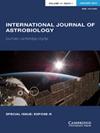抑制自我复制机器的繁殖
IF 1
4区 物理与天体物理
Q3 ASTRONOMY & ASTROPHYSICS
引用次数: 1
摘要
自复制机具有通用性和指数增长的生产能力,具有很高的实用性。他们的能力是无与伦比的。它们可以在短期内部署到月球上,利用当地的原位资源将其工业化,从而打开太阳系,然后部署到星际飞船上,通过开采原位恒星系统资源来探索整个银河系。然而,对于自我复制机器的固有安全性,存在着重大的担忧。为了防止灰粘问题,我们考虑了物理自复制机器中种群增长失控的一般问题,自复制机器产生的后代数量可以在遗传水平上加以控制。我们采用基于端粒的生物学启发方法,DNA端粒在细胞复制过程中逐渐缩短。这作为一个计数器,对复制周期的数量施加限制(海弗利克限制)。通过详细研究生物过程,我们可以在自我复制机器中实现类似机制方面获得一些见解。特别是,我们发现计数机制很容易发生癌变。本文章由计算机程序翻译,如有差异,请以英文原文为准。
Curbing the fruitfulness of self-replicating machines
Abstract The self-replicating machine has high utility by virtue of its universal construction properties and its productive capacity for exponential growth. Their capacity is unrivalled. They can be deployed to the Moon to industrialize it using local in-situ resources in the short term to open up the solar system and thence deployed on interstellar spacecraft to explore the entire Galaxy by exploiting in-situ stellar system resources. Nevertheless, there are significant concerns regarding the inherent safety of self-replicating machines. We consider the general problem of runaway population growth in physical self-replicating machines to prevent the grey goo problem, the number of offspring spawned by self-replicating machines may be controlled at a genetic level. We adopt a biologically-inspired approach based on telomeres, DNA endcaps that are progressively shortened during cellular replication. This acts as a counter that imposes a limit to the number of replication cycles (Hayflick limit). By examining the biological process in detail, we can obtain some insights in implementing similar mechanisms in self-replicating machines. In particular, we find that counting mechanisms are vulnerable to cancerous runaway.
求助全文
通过发布文献求助,成功后即可免费获取论文全文。
去求助
来源期刊

International Journal of Astrobiology
地学天文-地球科学综合
CiteScore
3.70
自引率
11.80%
发文量
45
审稿时长
>12 weeks
期刊介绍:
International Journal of Astrobiology is the peer-reviewed forum for practitioners in this exciting interdisciplinary field. Coverage includes cosmic prebiotic chemistry, planetary evolution, the search for planetary systems and habitable zones, extremophile biology and experimental simulation of extraterrestrial environments, Mars as an abode of life, life detection in our solar system and beyond, the search for extraterrestrial intelligence, the history of the science of astrobiology, as well as societal and educational aspects of astrobiology. Occasionally an issue of the journal is devoted to the keynote plenary research papers from an international meeting. A notable feature of the journal is the global distribution of its authors.
 求助内容:
求助内容: 应助结果提醒方式:
应助结果提醒方式:


